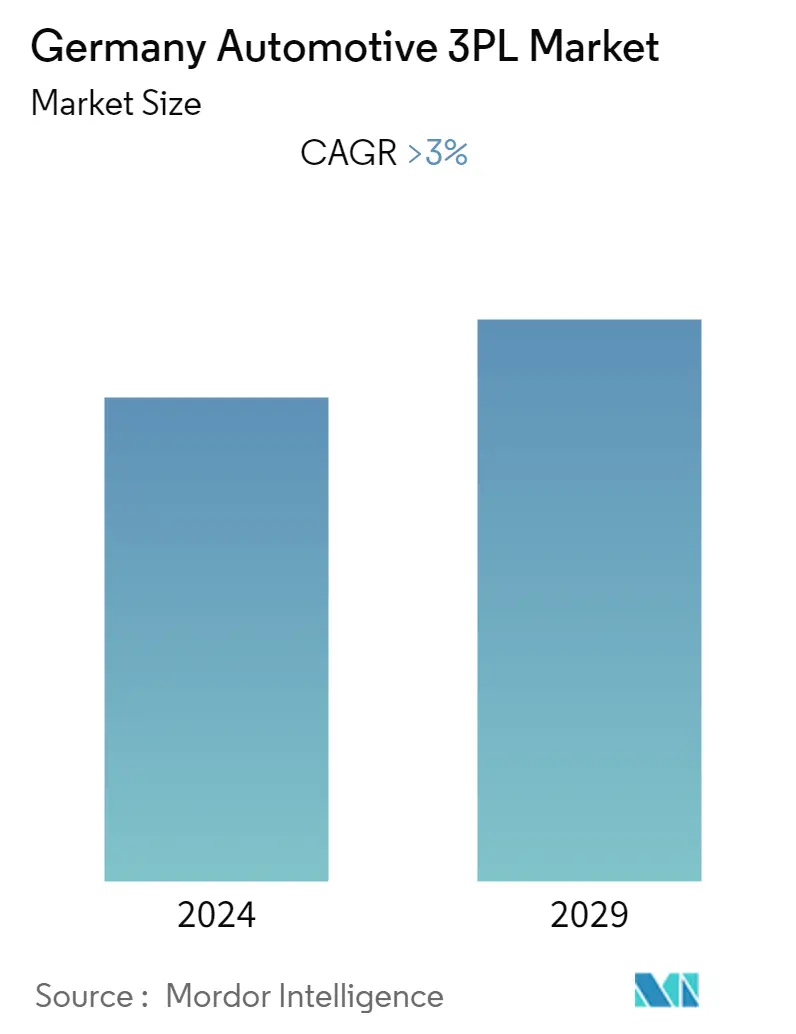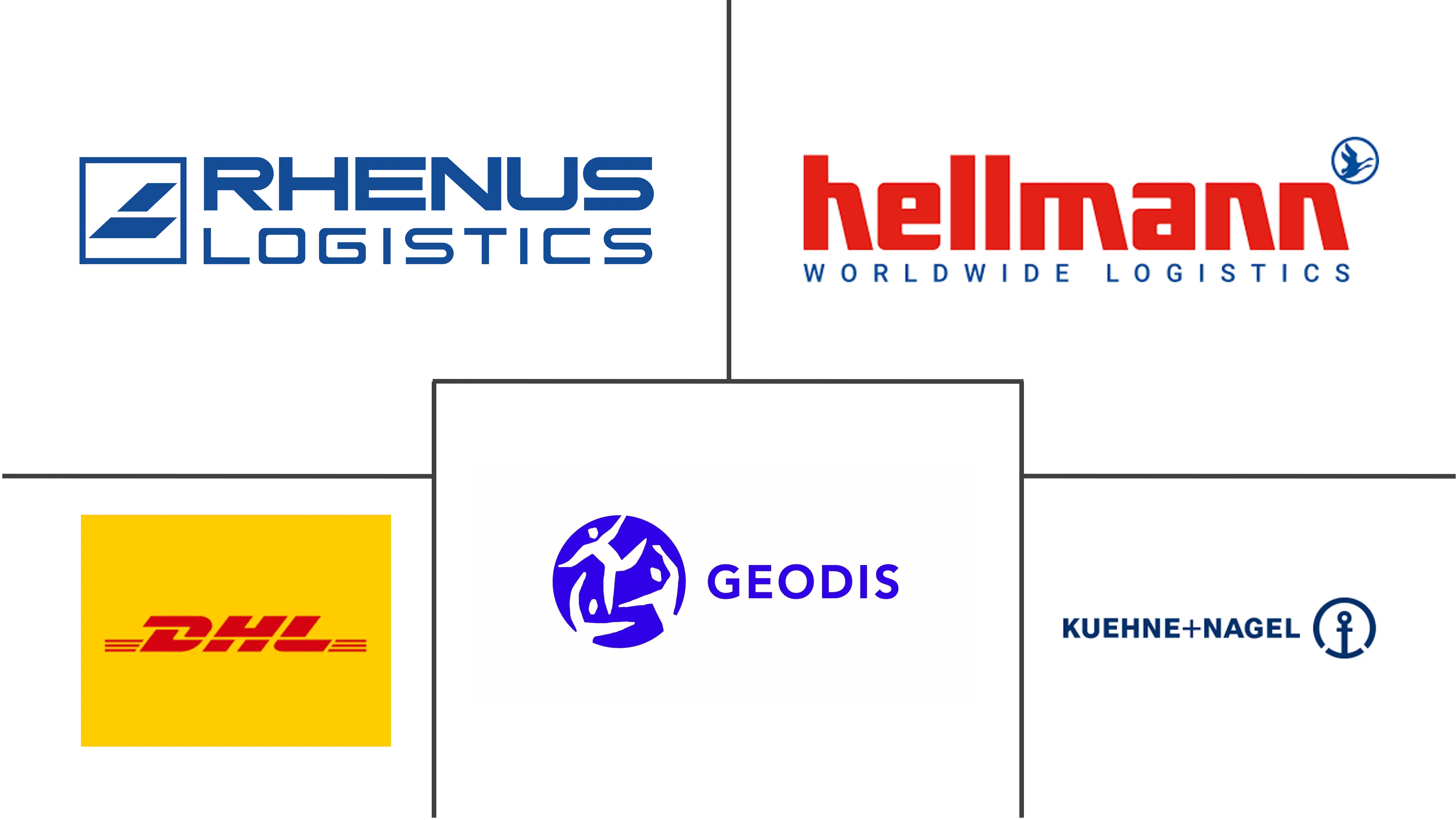Market Size of Germany Automotive 3PL Industry

| Study Period | 2019 - 2029 |
| Base Year For Estimation | 2023 |
| Forecast Data Period | 2024 - 2029 |
| Historical Data Period | 2019 - 2022 |
| CAGR | > 3.00 % |
| Market Concentration | Low |
Major Players
*Disclaimer: Major Players sorted in no particular order |
Germany Automotive Third Party Logistics (3PL) Market Analysis
The Germany Automotive Third-Party Logistics (3PL) market is currently pegged at a value of around USD 10 billion and is anticipated to register a CAGR of more than 3% over the forecast period.
- Germany is Europe's biggest automotive market, number one in production and sales terms, accounting for around 25 percent of all passenger cars manufactured and almost 20 percent of all new registrations. Germany also boasts the largest concentration of OEM (Original Equipment Manufacturers) plants in Europe. There are currently 44 OEM sites located in Germany. German OEM market share in the EU was more than 55 percent in 2021.
- Germany's auto sector is bouncing back from the COVID-19 pandemic with a broad array of forward-looking instruments and measures that will transform both the industry and future mobility. Significant investment in autonomous driving and battery research and development, massive expansion of charging infrastructure, and electric vehicle cash incentives are driving prospects in the resurgent industry.
- German OEMs were responsible for internal R&D investments amounting to almost EUR 28.3 billion (USD 30 billion) in 2021. Germany's automotive sector is the country's most innovative industry sector, accounting for 34.1 percent of total German industry R&D expenditure of around EUR 71 billion (USD 75.26 billion) in 2020. Research and development personnel within the German automobile industry reached a level of around 134,000. Manufacturers and suppliers in the German automotive industry will invest more than EUR 220 billion (USD 233.2 billion) in electric mobility and digitalization for the period 2022-2026.
- As Germany is a regional hub, it is a preferred location for manufacturers who can benefit from the ecosystem of leading shippers and third-party logistics providers (3PLs) in the country. The demand for warehousing space has expanded in the past decade, and over the forecast period, it is expected to be boosted by growth in regional trade and e-commerce.
- Not only is Germany's logistics infrastructure world-class, but its companies are also global logistics leaders. In fact, the world's largest logistics service provider is a German company, Deutsche Post (DHL). Deutsche Bahn operates Europe's largest rail network, and Lufthansa Cargo is one of the world's leading global air freight companies.
Germany Automotive Third Party Logistics (3PL) Industry Segmentation
Automotive third-party logistics companies provide services that have to do with the automotive logistics of the supply chain. This includes transportation, warehousing, picking and packing, inventory forecasting, order fulfillment, packaging, and freight forwarding. A 3PL (third-party logistics) provider offers outsourced automotive logistics services, which encompass the management of one or more facets of procurement and fulfillment activities. In business, 3PL has a broad meaning that applies to any service contract that involves storing or shipping items. A 3PL service may be a single provider, such as transportation or warehouse storage, or it can be a systemwide bundle of services capable of handling supply chain management.
The Germany Automotive 3PL Market is segmented by service (transportation, warehousing, distribution, inventory management, and other services) and by type (finished vehicles and auto components). The report offers market sizes and forecasts for the Germany Automotive 3PL Market in value (USD) for all the above segments.
| By Type | |
| Finished Vehicle | |
| Auto Component |
| By Service | |
| Transportation | |
| Warehousing, Distribution, and Inventory Management | |
| Other Services |
Germany Automotive 3PL Market Size Summary
The German Automotive Third-Party Logistics (3PL) market is a pivotal component of Europe's largest automotive industry, characterized by its robust infrastructure and strategic position as a regional hub. Germany's automotive sector, renowned for its innovation and significant R&D investments, is experiencing a resurgence post-pandemic, driven by advancements in electric vehicles and autonomous driving technologies. The country's logistics landscape is bolstered by world-class companies like Deutsche Post DHL and Deutsche Bahn, which enhance its global logistics capabilities. The demand for warehousing and logistics services is expected to grow, fueled by increasing regional trade and e-commerce activities. This growth is further supported by Germany's status as a leading exporter of vehicles, with a strong focus on electric mobility and digitalization.
The competitive landscape of the German Automotive 3PL market is marked by the presence of both domestic and international players, such as Honold and Kuehne + Nagel International AG, who leverage Germany's advanced logistics infrastructure. The market is witnessing intensified competition due to the booming electric and hybrid vehicle segments, which are reshaping logistics demands. Strategic acquisitions, like AD Ports Group's acquisition of Sesé Auto Logistics, highlight the dynamic nature of the market, as companies seek to expand their capabilities and strengthen their positions. The ongoing transformation towards electric vehicles is not only driving innovation but also creating new opportunities for 3PL providers to cater to the evolving needs of the automotive industry.
Germany Automotive 3PL Market Size - Table of Contents
-
1. MARKET INSIGHTS
-
1.1 Market Overview
-
1.2 Technological Trends in the Automotive Logistics Market
-
1.3 Government Regulations and Initiatives
-
1.4 Industry Value Chain Analysis
-
1.5 Spotlight - Effect of E-commerce on the Traditional Automotive Logistics Supply Chain
-
1.6 Insights into the Automotive Aftermarket and its Logistics Activities
-
1.7 Impact of COVID-19 on the Market (Short-term and Long-term Effects on the Industry as well as regional economy)
-
-
2. MARKET SEGMENTATION
-
2.1 By Type
-
2.1.1 Finished Vehicle
-
2.1.2 Auto Component
-
-
2.2 By Service
-
2.2.1 Transportation
-
2.2.2 Warehousing, Distribution, and Inventory Management
-
2.2.3 Other Services
-
-
Germany Automotive 3PL Market Size FAQs
What is the current Germany Automotive 3PL Market size?
The Germany Automotive 3PL Market is projected to register a CAGR of greater than 3% during the forecast period (2024-2029)
Who are the key players in Germany Automotive 3PL Market?
Hellmann Worldwide Logistic, Rhenus Logistics, DHL Post, Geodis and Kuehne + Nagel International AG are the major companies operating in the Germany Automotive 3PL Market.

